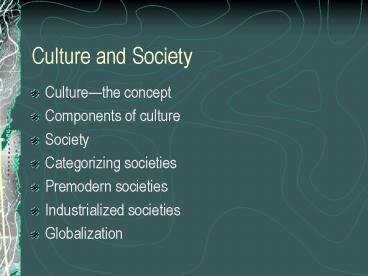Culture and Society - PowerPoint PPT Presentation
1 / 39
Title:
Culture and Society
Description:
Primitive Communism (classless) Slavery (masters vs. slaves) ... Communism (classless, stateless) 'Class struggle is the motor of history' Premodern societies ... – PowerPoint PPT presentation
Number of Views:773
Avg rating:3.0/5.0
Title: Culture and Society
1
Culture and Society
- Culturethe concept
- Components of culture
- Society
- Categorizing societies
- Premodern societies
- Industrialized societies
- Globalization
2
Culturethe concept
- A shared set of norms, beliefs, and values that
guide the social life of a group, and the
material products of that group. - Becker what is it that allows us to act together
without missteps and conflict? - Redfield (in Becker) conventional
understandings made manifest in act and artifact - A way of life
- Where does it come from? Becker imposed and
invented, continuously
3
Components of culture
- Objects (material culture)
- Symbols (non-material culture)
4
Material culture
- The physical artifacts or objects made by humans
in society
- Technology
- the tools and techniques used in production
- the link between culture and nature
5
Nonmaterial culture
- Intangible products of social life
6
Two important types of ideas that give culture
the capacity to guide social life
- Values
- Abstract ideals
- Ideas about what is right, good, preferred
- Examples?
- Norms
- Specific principles or rules of expected
behavior dos donts - Types
- Folkways
- Mores
- Taboos
- Laws
7
What are these?
8
9
(No Transcript)
10
(No Transcript)
11
money
12
What do they all have in common?
- They are symbols.
13
symbol
- An item that stands for or represents another
item - Words are symbols
- Language is a system of symbols that carry
meanings, including abstract ideas
14
(No Transcript)
15
(No Transcript)
16
(No Transcript)
17
What do all these have in common?
- They are signifiers.
18
signifier
- Any vehicle of meaning
- Can be sound, gesture, image, object, or even a
style - A symbol is a type of signifier (involving
motivation-meaning)
19
Semiotics
- Analysis of nonverbal cultural meanings
20
Example of semiotics ritual buildings
- Christian church with spire male-centered,
heaven-oriented - Hopi kiva female-centered, earth-oriented
- Old norm that spire was highest building
- New urban norm of skyscraper
21
Cultural identity
- we take our own culture for granted, assume it as
the norm culture is an important part of our
identity - this can also take the form of a subculture
examples? - judging other cultures by ones own cultural
standards is ethnocentrism - social scientists strive for cultural relativism
understanding another culture by its own
standards
22
Society
- A group of people who live in a specific place
with its own political authority and are aware of
their shared identity.
23
society
- System of interrelationships
- A macro social structure
- Industrialization and globalization are the main
drift of this period of history
24
Categorizing societies
- Marxs concept mode of production
- Non-Marxists level of material culture
(technology) taken as key indicator - Societies divided into pre-capitalist/capitalist
by marxists, premodern/modern by non-marxists.
25
Categorizing societies
- Mode of production
- forces of production (technology) and relations
of production (classes) - periods defined by key classes
- primitive communism
- slavery
- Feudalism
- Capitalism
- socialism
- Material culture
- complexity of technology and source of energy key
- sociocultural evolution assumed, but all levels
still exist - hunting and gathering
- agrarian
- pastoral
- traditional states or civilizations
- industrial
26
Marxs Historical Materialism (vulgar version,
based on statements in A Contribution to the
Critique of Political Economy)
Communism (classless, stateless)
Socialism (dictatorship of the proletariat)
Class struggle is the motor of history
Capitalism (capital vs. labor)
Feudalism (lords vs. peasants
Slavery (masters vs. slaves)
Primitive Communism (classless)
27
Premodern societies
- Review table 3.1
28
Hunting and gathering
29
Eating Christmas in the Kalahari
- How is stratification minimized in a gift-based
mode of exchange?
30
Agrarian
(
)
31
Pastoral
32
Traditional state or civilization
33
Industrialized societies
34
Industrialized societies
- Industrialization emergence of machine
production based on the use of inanimate power
sources.
35
Industrialized societies characteristics
- Rapid technological innovation (Marx sez
capitalism causes this) - More non-agricultural workers than farmers
- Urbanization
- Nation-state
36
Nation-state
- Political community with clearly delimited
borders - Distinguished from traditional states with
fluctuating frontiers - All modern societies are nation-states
37
Nation-states
38
World system globalization
- Three worlds?
- Product of colonialism expansion of European,
Japanese and American power (first world) - Second world product of state socialism (marxist
model) - Third world formerly colonized peoples now
either poor or newly industrializing
39
globalization
- Now clearly a World System in economic and
political sense - Also cultural influencesboth ways
- Jihad vs. McWorld (Benjamin Barber)































